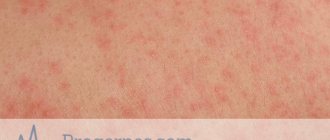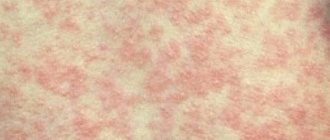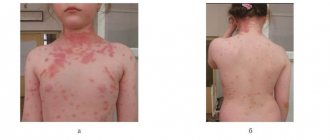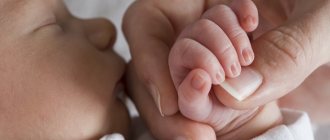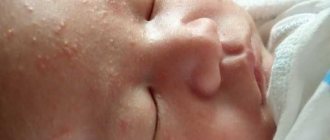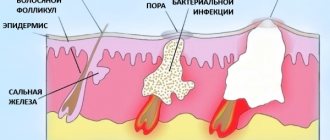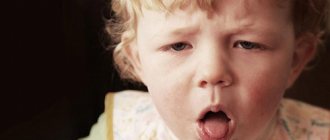Important
Children most often suffer from atopic bronchial asthma. Its cause is an allergic reaction, leading to a narrowing of the lumen of the bronchi. It usually occurs upon contact with inhaled allergens: house dust, animal hair and dander, plant pollen, mold spores. However, in young children, exposure to food allergens can also trigger the development of asthma.
Article on the topic Bronchial asthma: first symptoms and prevention of attacks Cases of infectious-allergic asthma, which occurs against the background of chronic respiratory tract infections (for example, chronic bronchitis), are recorded much less frequently in children than in adults.
The first signs of asthma in children
Asthma can be quite common in children, and it is very important for parents to know how to recognize the onset of the disease and what to do next. With bronchial asthma, the mucous membranes of the bronchi become inflamed.
As a rule, the cause is an allergy. Inflammation narrows the airway, making it difficult for the child to breathe. Usually asthma is paroxysmal.
When the attack ends, normal breathing is restored. The most important thing is to normalize the child’s breathing during an asthma attack.
At the slightest symptoms similar to signs of asthma, it is necessary to immediately take the child to see a specialist who will prescribe adequate treatment to prevent new attacks of the disease.
Note to mom
Diagnosing bronchial asthma in children is a more difficult task than identifying the disease in adults. This is due to the fact that with moderate manifestations of respiratory discomfort, a child, especially a small one, cannot always adequately describe what he feels.
In addition, in children under five years of age, the bronchi, compared to the bronchi of adults, have a narrower lumen and less developed muscular apparatus. Because of this, the leading manifestations of asthma in many children are not bronchospasm and suffocation (which is typical for adults and children over 5 years old), but swelling of the bronchial mucosa and abundant production of thick sputum. Not only parents, but sometimes doctors mistakenly consider this to be signs of ARVI or bronchitis. So, although the disease can develop from an early age, it is not diagnosed immediately.
However, an attentive parent may notice that the child has more than just a cold. This is indicated by a number of signs.
With asthma, a dry paroxysmal cough in a child occurs (or sharply intensifies) mainly at night or upon awakening.
The baby has wheezing.
Article on the topic
If you have allergies, see a psychologist! Asthma can occur due to stress and nerves. Your child regularly complains of difficulty breathing or you notice that it is difficult from time to time.
Cough or breathing problems occur when in contact with animals, house dust, during trips to nature during the flowering period of plants, during physical or strong emotional stress.
In these cases, you need to take your child to a pulmonologist and undergo an examination.
Treatment of infectious bronchial asthma
A very important step during the diagnosis of bronchial asthma is the detection of an infectious focus. In most cases, it is located in the lungs, but can also be localized in the nasal cavity and gall bladder. Tuberculosis is considered one of the types of allergic infections. There are cases in medicine where, with surgical intervention or timely treatment of a disease, a patient was relieved of bronchial asthma.
Improvement of the child's condition and complete treatment are carried out using complex therapy. It includes taking bronchodilators and performing breathing exercises to maintain normal functioning of the respiratory organs and tracts between attacks. An important point of therapy is inhalation. They help ease breathing during physical activity and reduce the effect of bronchospasm on the general condition of the body.
In the treatment of infectious bronchial asthma, anti-inflammatory drugs are often prescribed. They fight infection very well, but the downside is that they don’t start working right away. Such medications noticeably improve the condition on the third to fifth day after starting treatment, so they are not suitable for quickly eliminating an attack. But bronchodilators instantly act on the muscle cells of the body, relieve spasms, which helps stop the attack. These drugs are well accepted by the patient’s body, but do not affect general allergic inflammation, so a set of procedures is necessary to eliminate the cause.
And even when doctors notice an improvement in the clinical picture, it is necessary to continue monitoring with functional studies.
The thing is that lung function in its recovery significantly lags behind the improvement in the general condition of the body. For example, often in a child who no longer feels regular attacks of suffocation, breathes freely and does not complain of difficulties during physical activity, functional studies still show obvious disturbances in the respiratory system. Even with the complete cessation of whistling and wheezing in the lungs, the patient cannot be considered completely healthy.
This clinical picture indicates that after a course of treatment it is necessary to undergo a course of recovery. Modern treatment methods offer herbal medicine to correct possible pulmonary dysfunctions, taking into account the patient’s age and the characteristics of the diagnosis. Those plants that are used to create anti-inflammatory drugs can cope with infectious bronchial asthma. These are St. John's wort, marshmallow, medicinal calendula, elecampane, large plantain, naked licorice and other herbs that can remove infections from the body.
SOS
As a rule, an attack of bronchial asthma begins with a cough; a runny nose and hives may also appear. The child's breathing becomes uneven: inhalation is short, exhalation is difficult. It is accompanied by wheezing and whistling, he “catches air” with his mouth. The lips may become bluish and the skin may become pale.
For such symptoms, the child should be seated in a chair, tilted forward so that the elbows rest on the knees, and the window should be opened to provide air flow (but the room should not become cold). It is necessary to use, according to the instructions, an inhaler with a medicine that relieves bronchospasm (a drug from the group of beta-2-adrenergic agonists). You can also take hot baths for your hands and feet.
It is very important to remain calm and distract the child’s attention, for example, read him a book or give him a favorite toy. The main thing is not to let him get too scared, because fear and panic greatly aggravate the condition during an attack.
Article on the topic
Bronchial asthma: everyone is at risk of getting sick If the attack persists, call an ambulance.
First symptoms of asthma
The first symptoms of asthma are often subtle and may resemble those of a cold or allergy.
The development of bronchial asthma is often preceded by so-called preasthma.
This condition is characterized by the absence of disturbances in the functioning of the lungs, however, the onset of the disease may be indicated by the appearance of allergic reactions in the form of atopic dermatitis (eczema) or seasonal allergies to pollen, which did not exist before.
A potential asthmatic should also be wary of the increased frequency of respiratory viral infections, which in this case occur not only in the cold season, but also in late spring and summer.
Early symptoms of bronchial asthma also include:
- sudden onset of shortness of breath even at rest. In this case, an attack of shortness of breath can be triggered by exposure to polluted or very cold air on the respiratory tract, staying in a room with a lot of dust, or inhaling plant pollen.
- dry cough, which may accompany an attack of shortness of breath. Attacks of such a cough can be protracted - as if the patient has something in his windpipe and he is trying to “cough out” a non-existent foreign body.
- breathing rhythm disturbance. Inhalation occurs normally, but when trying to exhale, a person experiences significant difficulties, which is why he has to make significant efforts. In this case, the duration of exhalation becomes much longer than in healthy people. The breathing itself becomes frequent and shallow.
- The initial stage of bronchial asthma is also characterized by wheezing in the chest when breathing. Moreover, in many cases, such wheezing with a characteristic whistling “tinge” can be heard by those around the patient.
An important point that complicates the early diagnosis of bronchial asthma is that in the initial period of the disease, all of the listed symptoms can appear independently, separately, and irregularly, but as the disease progresses, their frequency and severity increases.
Risk factors
The nature of bronchial asthma is not fully understood. However, doctors identify several factors that increase the risk of getting sick.
Hereditary predisposition. It has been established that the risk of bronchial asthma is 2.6 times higher in children whose mothers suffer from this pathology, 2.5 times higher - if the father is ill, and 6.6 times higher - if both parents are sick.
Atopic dermatitis (diathesis) in early childhood, as well as other allergic diseases. Over time, they can “transform” into asthma.
Maternal smoking during pregnancy increases the child's risk of developing asthma by 25%. The prognosis also worsens significantly when adults smoke near the baby after birth. The severity of asthma directly depends on the number of cigarettes consumed daily. In such children, the first attacks of difficulty breathing often develop already at one month of age.
Unfavorable environmental conditions, for example, living near large enterprises or where the air is very dusty.
Frequent colds, if they cause complications in the bronchi. According to the results of one Russian study, 25% of children who were diagnosed with obstruction (narrowing of the lumen) of the bronchi caused by viruses subsequently developed bronchial asthma.
Forms of manifestation of the disease
If bronchial asthma began in childhood, it most often accompanies a person throughout his life. However, there are cases when, during puberty, the clinical picture of the disease weakens and disappears . But we must not forget that the increased reactivity of the bronchi continues to persist, so it is impossible to assume that the disease has receded. As soon as provoking factors arise, the symptoms of the disease will appear again.
Despite the fact that it is impossible to cure bronchial asthma forever, it is possible to treat and prevent the disease in a child. In addition, it is important to learn how to stop exacerbation of asthma in a timely manner, and in this case a person can live a full life - study, work, play sports.
There are the following forms of the disease:
- allergic or atopic form - develops under the influence of allergens;
- non-atopic form - provoked by stress, physical activity or cold air;
- mixed - in this case the two previous forms are combined;
- status asthmaticus is a condition that can be life-threatening because it is accompanied by obstructive phenomena in the small bronchi.
IMPORTANT! In childhood, asthmatic attacks are especially dangerous and severe, since a life-threatening condition can develop in a very short time.
This is due to the fact that in early childhood the diameter of the bronchi is significantly smaller than in adults, so swelling causes their persistent narrowing. In addition, in adults, obstructive processes in the bronchi are mainly associated not with swelling, but with bronchospasm, which significantly alleviates the situation.
Memo to parents
To reduce the number of asthma attacks, it is necessary to minimize contact with allergens that trigger them. Ideally, you first need to find out what exactly these substances are. To do this, allergy skin tests are performed or blood is tested for antibodies to allergens. If these examinations are unavailable for some reason, follow general safety rules.
Article on the topic
Rules of life for asthmatics: how to learn to control the disease As often as possible, carry out wet cleaning in the house and in the room where the child sleeps, does homework, and plays.
Use home air purifiers and humidifiers.
Avoid feather and down pillows, feather beds, replace them with bedding with synthetic filling. You can also use special impermeable covers for mattresses, pillows and blankets.
Remove rugs and rugs from the floor.
It is not advisable to buy soft toys for your child.
Make sure there is no mold in the house and the air is not too humid. Cockroaches should not be allowed to live in the apartment - their waste products are an allergen, very often leading to the development of asthma or an increase in attacks.
Avoid going outdoors during the flowering period of allergenic plants. In severe cases, at this time it is recommended, if possible, to go to a region with a different climate, where the flowering period has not yet begun or has already passed.
Preventive measures
There are a number of rules, the implementation of which significantly reduces the risk of developing an infectious-allergic form of bronchial asthma in humans:
- avoid contact with potential allergens (smoke, animal hair, dust, etc.);
- Healthy food;
- avoid nervous tension and stressful situations;
- treat colds in a timely manner;
- regularly ventilate the room, do wet cleaning;
- At the first symptoms, do not hesitate to contact a specialist.
If there is a genetic predisposition to bronchial asthma, it is necessary to carry out preventive measures that are aimed at reducing the impact of external and internal irritants.
It is also recommended to avoid severe hypothermia and observe good personal hygiene, this will help prevent the development of asthma.
Treatment
In addition to inhaled drugs that relieve asthma attacks, it is important to use drugs that improve the condition of the bronchi during periods of remission. They must be taken regularly, according to the schedule prescribed by the doctor.
A good solution is to conduct a course of allergen-specific immunotherapy (ASIT), especially if asthma attacks occur upon contact with an allergen that is difficult to eliminate. (For example, not everyone can leave during the flowering period of plants, just as not everyone can allow a child to go to school at this time.) The principle of such treatment is to “accustom” the body to allergens.
Article on the topic
Asthma is not caused by dust, fur or medications, but... by mold! The child is administered small amounts of substances to which he reacts with bronchospasm, gradually increasing the dose. Today this can be done either by injection or without injections. As a result, the immune system “gets used” to the allergen and stops reacting to it so sharply.
According to research, 75% of asthmatics who underwent ASIT did not develop clinical signs of the disease for 20 years; further observations of patients are ongoing.
Safety regulations
An asthmatic child should always have a metered-dose aerosol or powder inhaler with a bronchodilator with him, because an attack can occur suddenly.
Be sure to notify the kindergarten teachers and the class teacher at school about the illness. Asthma attacks can occur due to stress and emotional distress, and educators should be aware of the risk.
If an asthmatic child catches the flu, ARVI, or suffers from sinusitis or bronchitis, under no circumstances should you self-medicate. Only a doctor can treat such a patient, because with asthma you need to be very careful when choosing medications, including antipyretics and antibiotics.
| Drugs | |
| Beta-2-adrenergic agonists | |
| Combined drugs for the treatment of bronchial asthma | |
| Inhaled glucocorticoids | |
| Other drugs for the treatment of bronchial asthma | |
Remember, self-medication is life-threatening; consult a doctor for advice on the use of any medications.
Buy the printed version of the directory at kiosks in your city or order it from the editorial office by phone or email [email protected] with the mark PM (indicate your full name, postal address and telephone number in the letter).
Symptoms of the disease
Every parent should know how asthma can manifest. The signs in a child are usually pronounced. The baby begins to experience bronchospasm, which doctors call bronchial obstruction. This is expressed as follows. The child begins to have a paroxysmal dry cough. Over time, viscous sputum begins to be released.
You can tell that obstruction has begun by your breathing. If in a healthy child the duration of inhalation and exhalation is approximately the same, then with the development of an asthmatic attack shortness of breath appears. It is characterized by a short inhalation and a long exhalation. In this case, the patient experiences wheezing, which can be heard from afar.
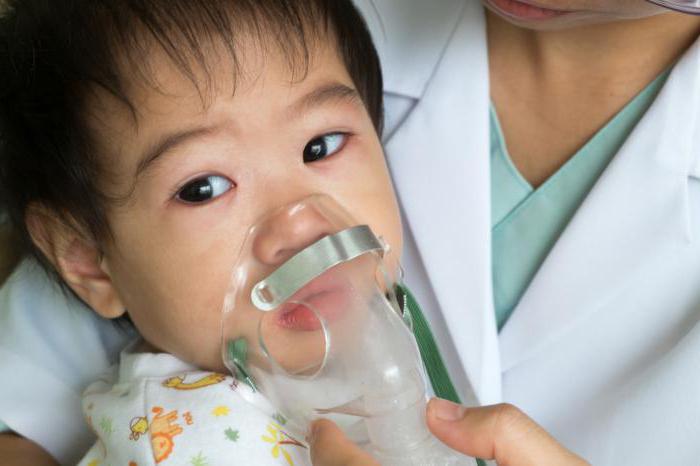
There are also so-called first signs of asthma in children, which are observed even before the onset of an attack. So, the baby begins to cough, there is nasal congestion and itchy skin.
During an attack, older children may complain of a feeling of lack of air, squeezing in the chest area. Children's sleep is disturbed, they become whiny, irritable, lethargic.

